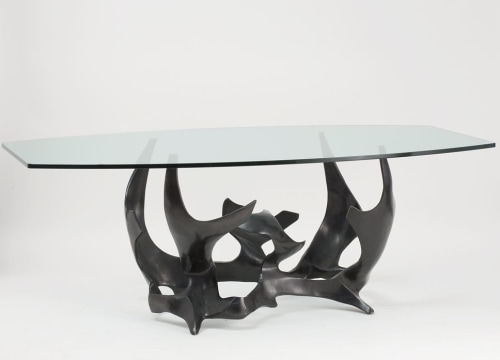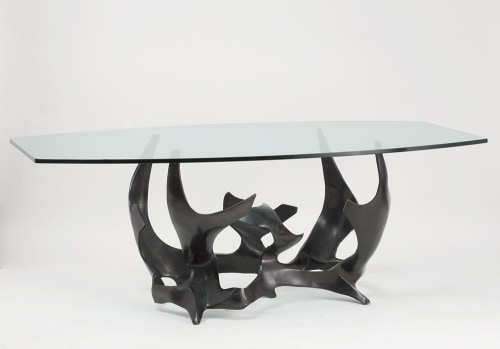

Fred Brouard was renowned in his time for bringing unique curves, striking finishes, and bold designs to the fore of late 20th century furnishings, lighting, and jewelry. As versatile as he was skilled, his body of work grew to include sconces, pendants, sculptures, and even large pieces of furniture such as dining tables. Well known as an exhibitor throughout his prolific career, many pieces survive today as a testament to his malleability as a sculptor.
Born in Normandy in 1944, Brouard first attended the Ecole des Beaux-Arts de Rouen, and there studied under sculptor/painter Savary Leleu. He later became serious about sculpting once he began attending the prestigious Ecole Nationale Superiure des Bauex-Arts in Paris. He began working in plaster to make his own art, while simultaneously apprenticing in the workshop of Henri-Georges Adam.
After serving for a time as assistant to sculptor Alicia Penalba, Brouard was able to begin exhibiting his creations. Having moved on to metal, he showed some of his pieces at the International Exhibition of Jewelry and Contemporary Art in Montreal, Canada in 1970. From there, he went on to open his own workshop in 1973, and began collaboration with the interior designer Emilio Maccioni, for whom he made some of his most unique functional creations in bronze.
Throughout the 1970s, Brouard continued to exhibit in France, participating in the Great Exhibition – Youth of Today (1974), the Biennale of Padua (Lausanne, Switzerland, 1975), and the International Exhibition of Vaudreuil (1978). Into the next decade, Brouard showed his work in Saudi Arabia and at the prestigious Salon d’Automne in Paris. Concurrent to these showings, the very prolific Brouard was completing public commissions for the Union Chamber of Automobile Importers and the General Council of l’Ain. Brouard’s efforts during this time solidified his reputation and his work’s immortality in contemporary French design, recognized with his participation in a 1986 show at the Museum of Modern Art in Paris.
Brouard’s work confirmed his versatility as a sculptor. With variances in scale (from the most delicate of jewelry to large, elegant furnishings) and a diversity of materials, Brouard showed himself to be a master of juxtaposition. Brouard’s work often evoked nature as well as industrial themes—reflecting himself as a man of the provinces in a modern world.
Though Brouard passed away in 1999, his work is still recognized as an important contribution to late 20th century design. His work can today be found in the collection of the National Fund for Contemporary Art in France. In addition to this, his pieces are fixtures in the private art market.